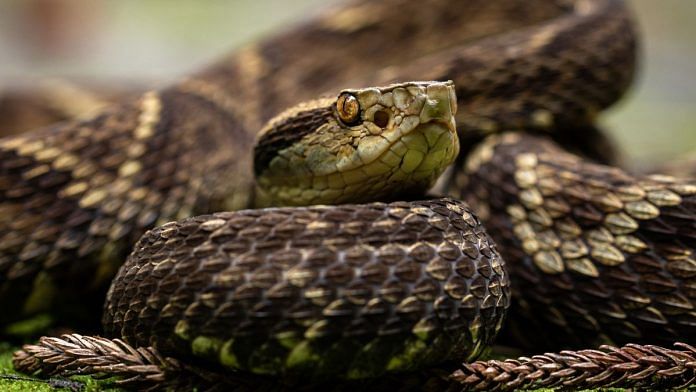New Delhi: Propelled by curiosity, a Brazilian biologist stepped on venomous snakes 40,000 times to understand what triggers them to bite.
João Miguel Alves-Nunes from Butantan Institute in São Paulo welcomed a den of jararacas, a pit viper species rife in south-eastern Brazil, into his laboratory to analyse their innate defence mechanism.
The risky and unconventional study helped gain insights into snake behaviour — the size and the sex of the snake, the type of human stimulus and the time of the day impacted bite probability.
Also, the jararacas in the coastal areas of Sao Paulo were more eager to use their fangs compared to those found in the highlands.
“I didn’t put my whole weight on my foot, so I did not hurt the snakes. I tested 116 animals and stepped 30 times on every animal, totalling 40,480 steps,” Alves-Nunes said in an interview with the peer-reviewed journal Science.
The findings, published in Nature’s Scientific Reports on 3 May, will likely empower local governments with the tools they require to predict where snakebites are more likely to occur, enabling the optimisation of antivenom distribution, Alves-Nunes told the interviewers.
The Brazilian biologist was troubled by the scarcity of research examining ecological factors that led snakes to brandish their fangs.
In the first-of-its-kind study, he and his team sought to pinpoint “the intrinsic and environmental factors that influence defensive behaviour and its relationship to snakebite epidemiology”.
Through their unconventional methodological approach, the researchers found that smaller female vipers are more prone to bite in response to non-physical stimulation in the mornings. Smaller males, on the other hand, had a higher probability of biting in the morning when touched.
The researchers also noticed that the tendency of female vipers to bite increased the warmer they were, independent of the time of day. But, for the male snakes, the tendency to bite at night was inversely proportional to their body temperature.
The developmental stage that the viper had reached also affected its tendency to bite. Newborn jararacas were 2.17 times more likely to bite than adults. Newborn females are the most prone to turn to the defence mechanism.
In general, jararacas tend to become more aggressive in hotter temperatures, and the probability of its defensive bite is much higher when the snake’s head is the target.
Finally, from epidemiological data collected in Sao Paulo uplands, the researchers found that while female vipers were responsible for 64% of snakebites in the morning, the trend reversed at night, with males responsible for 57% of envenomations.
The researchers hope that all this information will help governments worldwide to understand and predict epidemiological trends and establish more robust antivenom deployment systems. Snakebites account for 81,000 to 1,38,000 deaths annually, contributing to 58,000 fatalities in India.
Also read: Use of horses became widespread only around 2200 BCE, finds Nature study challenging timeline
Explaining snake behaviour with ‘feet of daring’
When he conceived of this radical method to study snake behaviour, Alves-Nunes seems to have defied an innate fear of snakes that most humans have.
Sporting protective leather boots covered in a foam layer and extending 3 centimetres above the knee, he would step into a room where a pit viper or Bothrops jararaca was held captive.
He would gently place his foot on the snake’s head, abdomen, and tail to determine the conditions under which the creature would likely bite in defence.
In his interview with Science, the biologist, when asked whether he felt safe sharing a room with venomous snakes, said, “They were leather boots covered in foam that went 3 centimetres above my knees. I felt 100% safe, and the jararaca bites never punctured them.”
“However, when I was doing simulations with a rattlesnake, one punctured the boot, and I was bitten,” he added.
Fortunately, he got bitten at the laboratory of an institute specialising in antivenom development. After the bite, Alves-Nunes learned that he was allergic to antivenom and had to leave future experimenting to his lab technicians, focusing instead on data analysis and experiment design.
Now, the scientist is busy “comparing the bite strength of rattlesnakes and jararacas and how resistant different materials and shoes are to them”, Alves-Nunes told the interviewers.
Granville Austin is an intern with ThePrint.
(Edited by Madhurita Goswami)
Also read: Life-sustaining freshwater first appeared on Earth 4 billion years ago, finds Nature study






